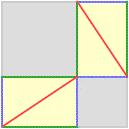November 18, 2002 (Addendum November 26, 2002)
Pythagorgrams
Pythagorgrams is a simple tangram-type learning widget to help students understand Pythagoras' theorem. I began it as a design exercise, but I like the way it turned out well enough to spread it around, so here it is.
|
|
Design Notes. My goals for this widget were to make it as simple as possible, and to make it "interactive".
• In this context, "simple" refers more to the mathematics than to the interface. There are many different proofs of Pythagoras' theorem (see Alexander Bogomolny's Cut the Knot site for an extensive list). Conceptually, this one is the simplest I know of: it avoids algebraic manipulations and requires only an intuitive understanding of the additivity of areas and their invariance under translations (i.e. no rotations or shearing). The proof is usually presented as a static "behold!" type proof (pictures only):


Simplicity is extremely important in the design of all onscreen learning materials, to make the content accessible to a wide range of student abilities and with minimal teacher intervention.
• "Interactivity" is very much a buzzword at the moment; everyone wants interactivity, but it's hard to pin down precisely what it's supposed to be, let alone how it works or how to implement it. Here, I mean only that I want the students to build the proof - to discover the pictures rather than merely view them or an animation of them. Since most school students are familiar with tangrams, framing the interactivity as tangram-like puzzles seems to be a good way to motivate students, though the puzzles themselves are easy to solve. The mathematical "rigour" (what there is of it) occurs only at the end (question 6), after the basic structure of the proof is understood. (As a research mathematician, I can attest that most mathematical discovery follows this sequence, despite the way it's presented in research papers.)
• Other notes. The one thing I don't like about this proof is that at no point does there appear a complete picture of the right-angled triangle with a square on each side. I think that image is important, so I made it into the "logo". Note that the logo is "live", i.e. it changes as the triangle does.
It would not be difficult to incorporate solutions to the puzzles and answers to the questions under the tabs. My inclination is not to, first because I think that impatient students would go there immediately rather than thinking through the questions, but also because the material is pretty easy and largely self-correcting anyway. Opinions, anyone?
I'd appreciate any feedback on this widget, particularly on its design, but also technical feedback: does it work the way you would expect? Can you break it? and if so, how? Are there ways I can improve it? Finally, it's very likely that this popular proof has been made interactive this way before, though the examples I've been able to find use special cases (e.g. with the usual tangram pieces or for special triangles). Please send me any links to similar general, interactive proofs.
November 26, 2002: Addendum
Thanks to everyone who contributed feedback. There's a good collection of interactive Pythagoras "mathlets" at Manipula Math, including one which is in essence the one above, but without the questions. And of course, there are many other Pythagoras mathlets elsewhere.
By popular demand, Pythagorgrams (with a few minor edits) now has its own webpage (i.e. sans design notes). I've also added a collection of problems to make it into a more complete learning activity. A few notes: beyond the first problem, (intended only to make sure the theorem is understood correctly), I've tried to make the problems rich in ideas with minimal computations; some are also meant as precursors to ideas in trigonometry, analytic geometry, etc.. I've deliberately not included "real-world" applications (except possibly the last problem), since real-world applications tend to be no more mathematically interesting or difficult than a straightforward application of the formula to an obvious triangle. (I'd be delighted to see one that isn't, if you have one.)
As usual, any comments on the problems are welcome.